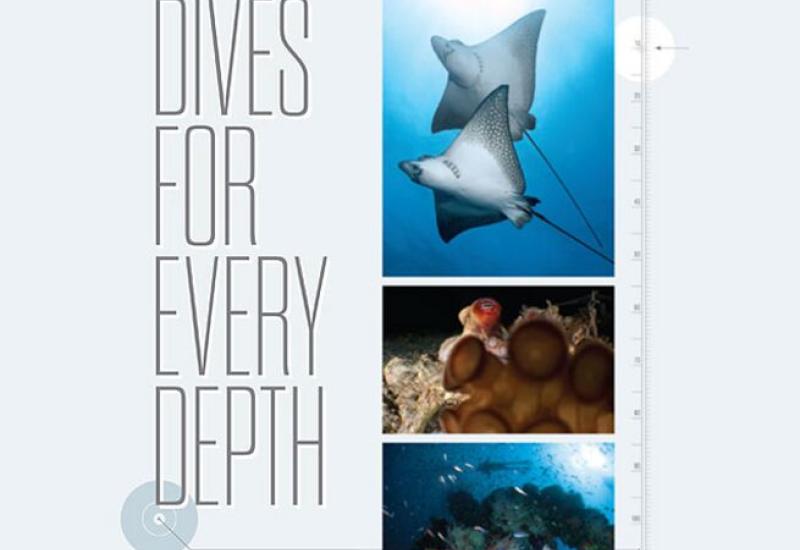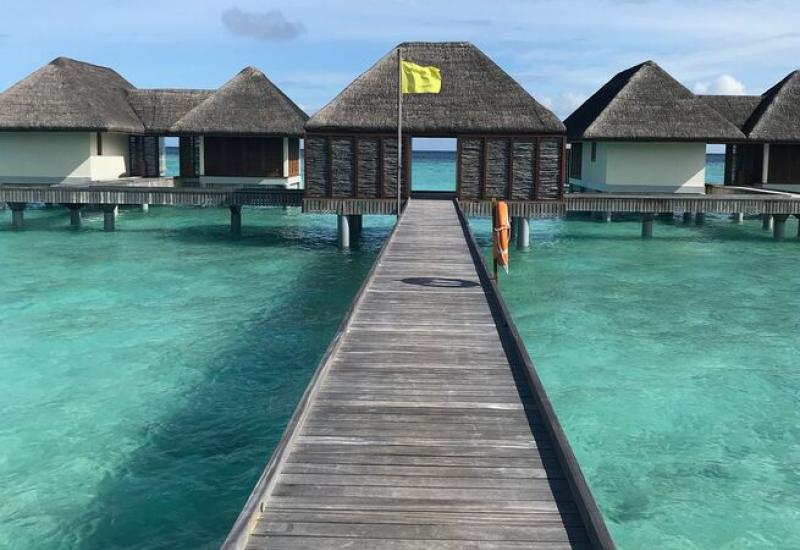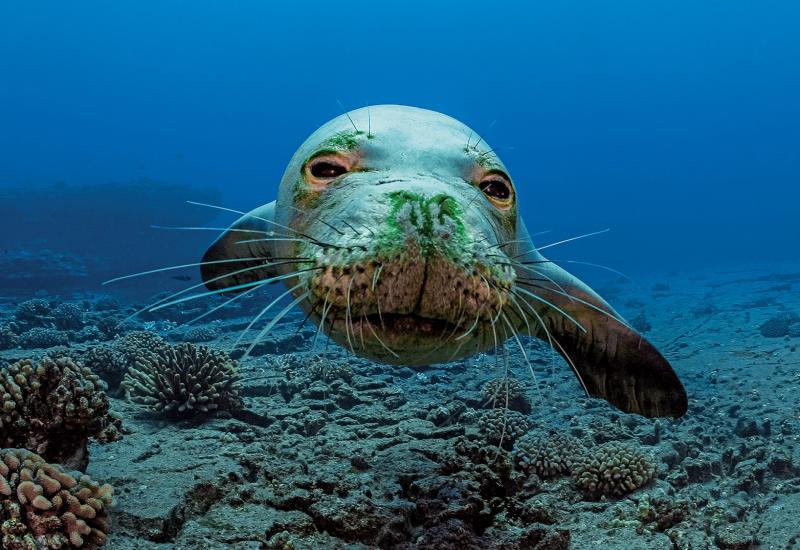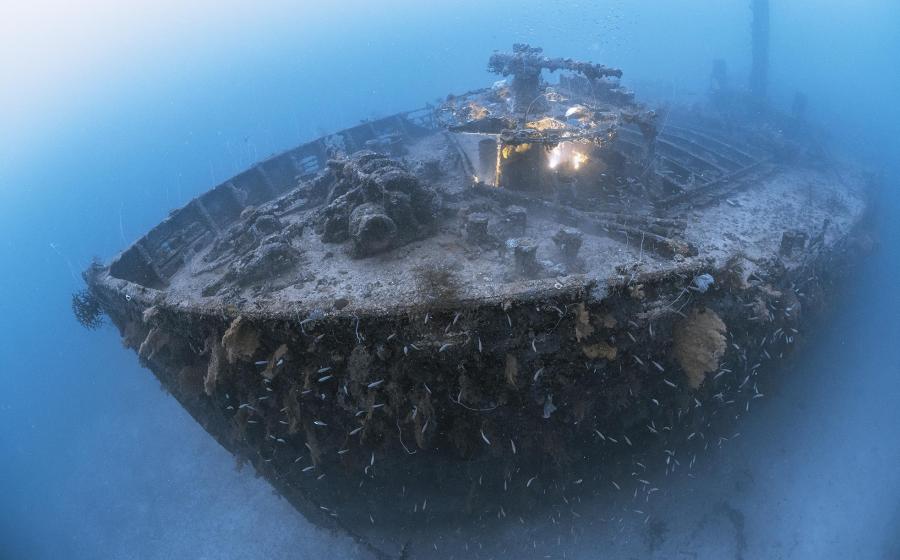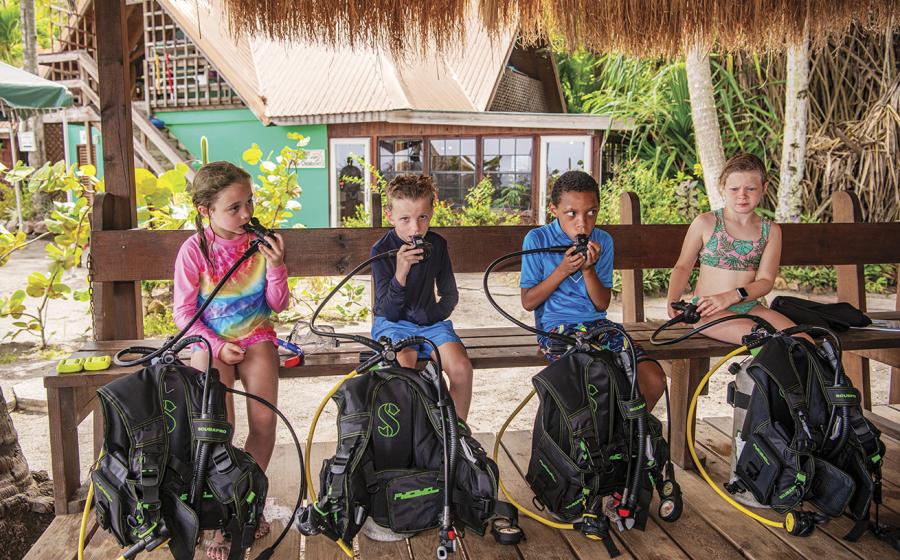The 10 Best Shallow Scuba Diving Sites

Jennifer PennerWe’ve found 10 places where sticking close to the surface pays off with endless bottom time and nonstop action.
We divers love the deep blue sea. After all, one of the main reasons to get certified is the sheer pleasure of venturing beyond the snorkel zone (a diver’s equivalent of the dreaded friend zone). But for all the thrill of finning around at depth, there are shallow dives that rival their deeper sister sites.
For starters, you’ll have more bottom time when you’re tooling around where the sun still shines. Those natural light conditions are an underwater photographer’s dream. And while there are reasons to go deep — to explore a wreck, for instance — staying shallow doesn’t mean you’ll miss out on spectacular diving. From sea lion encounters in the Sea of Cortez to the fish-frenzied reefs of Sulawesi, here are 10 shallow sites that deliver deep-end diving thrills. And if you want to explore deeper, on many of these you can — plus, we've paired our shallow-site faves with nearby deeper ones. There is something for everyone!

Brandon ColeA secretary blenny peeks out of his coral hole at Scott's Head Drop-Off in Dominica
1. The Plateau at Scott’s Head Drop-Off | Dominica | 15 feet
The chance to blow bubbles in a submerged volcanic crater brings divers to Soufriere-Scott’s Head Marine Reserve, a UNESCO-listed zone of unspoiled coral walls on the southwest side of Dominica. “Because the area is protected from the Atlantic Ocean by a peninsula, the visibility is very good here most of the time,” says Niels Noteboom, dive operations manager for Buddy Dive Dominica. He points to Scott’s Head Drop-Off as the island’s top shallow dive. While you can get deeper here, the plateau at the top, in about 15 feet of water, is often done as a safety stop. But it's so awesome, it is worth an entire dive. Pink and bright-blue vase sponges and yellow tube sponges decorate the tabletop shelf like bouquets of flowers, and lobsters and crabs peek out from nearly every nook and cranny. Be sure to scan the sand at the top of the wall for one of the most entertaining Caribbean denizens: the genie-like yellowhead jawfish, which may sport a mouthful of eggs as it hovers nervously near its hidey-hole. buddydivedominica.com
Deep-Dive Counterpart | Dangleben’s Pinnacles
35 TO 80 FEET
Best dived when moderate currents attract large schools of jacks, creole wrasse and snapper to the five pinnacles here, this Soufriere Bay site has huge barrel sponges and colorful crinoids.
2. Stingray City | Grand Cayman | 15 feet
Southern stingrays that bumble around like excitable puppy dogs arrive en masse at this snorkel and dive site in the North Sound of Grand Cayman. Once here, all you have to do is get into position — hovering over or kneeling on the sandy bottom in just 15 feet of water — and sit back and enjoy the show. There are usually up to 20 rays at a time carving turns in the crystal-clear water. The rays first began gathering here decades ago when fishermen used the shallow area to clean the day’s catch. Divers later started feeding the rays squid snacks, but that might not be the only thing attracting them here these days. “It’s possible the rays actually enjoy the bubbles,” says Jason Belport of Cobalt Coast in Grand Cayman, which runs regular trips to the site. So exhale away (your bottom time is practically limitless), and enjoy getting to know your new friends. cobaltcoast.com
Deep-Dive Counterpart | Babylon
40 TO 100 FEET
In a remote location on Grand Cayman’s famed North Wall, the large pinnacle and canyon at Babylon are festooned with black corals and barrel sponges, and ripples with schooling chromis.

Allison Vitsky SallmonLush corals and sponges line the pilings of Bonaire's Salt Pier
3. Salt Pier | Bonaire | 25 feet
With their daddy-longleg pilings, piers are magnets for marine life. But the Salt Pier in Bonaire takes the Caribbean cake when it comes to the sheer volume of fish to be seen in waters that barely push the 30-foot mark. Still active, the pier can be dived only when it’s free of docking ships. You’ll gear up on shore, with pyramids of Bonaire’s prized salt for a bizarrely beautiful backdrop. When you submerge, it’s to swarms of fish schooling between steel pilings encrusted with colorful sponges and corals. “Salt Pier was akin to diving Sipadan in Borneo in terms of the sheer volume of fish,” says travel writer Kristin Luna of the blog Camels & Chocolate. “It sets the bar very high for future Caribbean dives.” Yellowtail snappers shimmer in honey-hued clouds, and silvery grunts amass in their own entourages (schooling fish particularly like to gather in the shadows made by the hulking salt terminal). Look for lurking moray eels in the coral heads between the piers, and spot arrow crabs in the abundant anemones. wannadive.com
Deep-Dive Counterpart | Hilma Hooker
60 TO 100 FEET
This former drug-smuggling ship that sank off Bonaire in 1984 is a favorite Caribbean wreck dive thanks to layers of sponges and coral, prolific fish life, and a photogenic, massive bronze propeller.
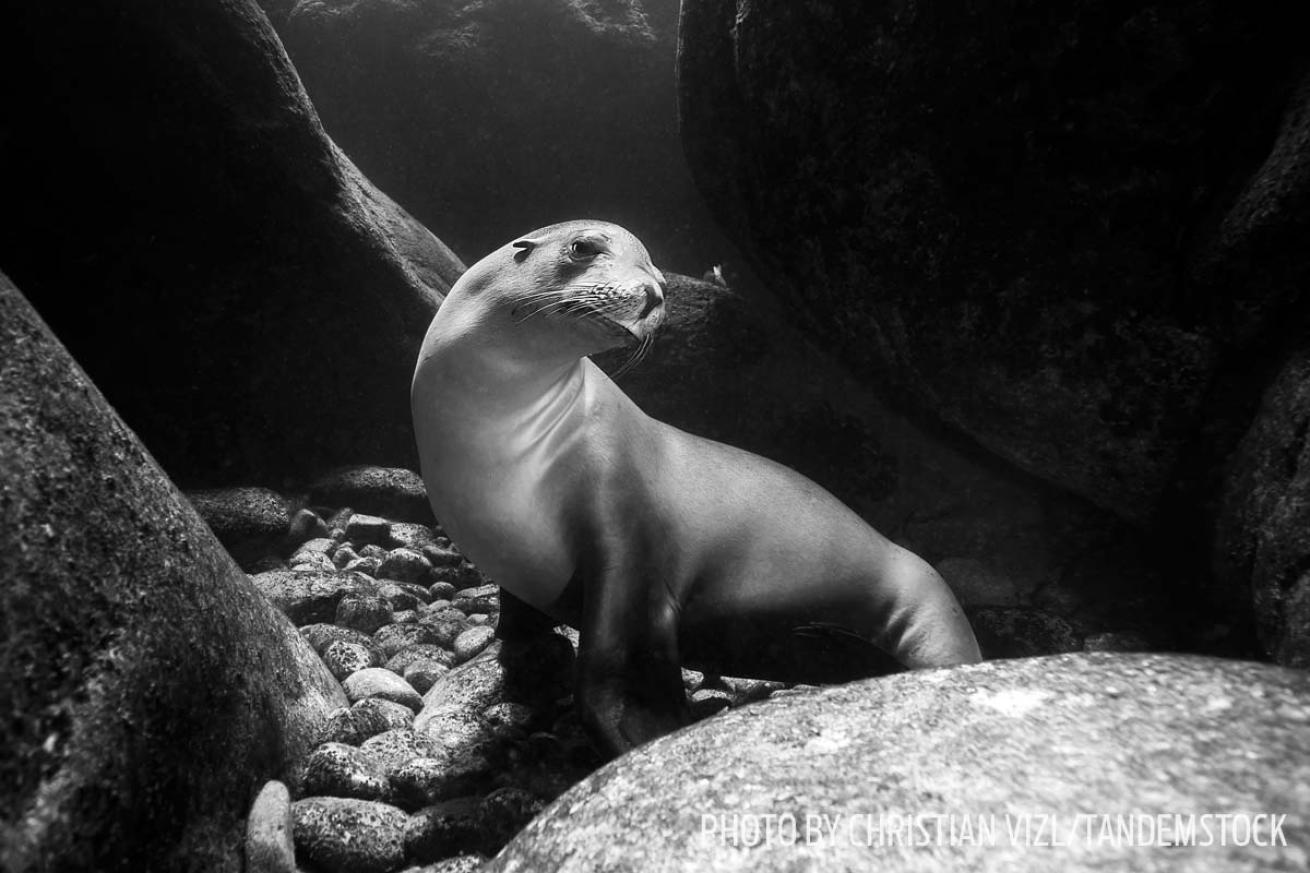
Christian Vizl/TandemstockA sea lion in the Sea of Cortez
4. Los Islotes | Sea of Cortez, Mexico | 30 feet
A cluster of jagged rocks sticking out of the ocean just north of La Paz is home to a colony of California sea lions that rolls some 400 extra-curious members deep. And when you enter the 30-foot-deep water here to dive, you’re guaranteed to see these black-eyed beauties up close — and quite personal too. “The same sea lions will come up to us and want us to cradle them, scratch them and interact with them.... It’s amazing,” says James Curtiss, owner of the Cortez Club. “[Diving among sea lions] is one of the most spectacular things there is to do.” A protected marine reserve, Los Islotes (Spanish for “the islets”) is also home to healthy soft and hard corals, parrotfish, Pacific creole fish, and large schools of sardines being divebombed by hungry cormorants. The water is so dazzlingly clear that even the most basic underwater camera can capture Instagram-worthy photos of the playful scene. If you’re here in mid-September, you’ll likely see baby sea lions making their first forays into the water. cortezclub.com
Deep-Dive Counterpart | El Bajo
55 TO 160 FEET
Three submerged pinnacles blow with the current most of the time, attracting schools of hammerhead sharks and, in late summer and early fall, manta rays.

Brandon ColeGoatfish, snapper, and anthias school over a colorful coral reef on which a large carpet sea anemone is home to anemonefish.
5. The Top of Steve’s Bommie | Ribbon Reefs, Australia | 10 feet
Divers who visit the Great Barrier Reef on day boats from Cairns hardly scratch the surface of the world’s largest coral reef. The most spectacular diving here is accessed by liveaboards that visit the remote Ribbon Reefs, a chain of 10 individual reefs etched like turquoise gashes into the sapphire sea. On the inside of Ribbon Reef No. 3 is where you’ll find Steve’s Bommie, a superlative pinnacle that rises from around 100 feet to just a few feet below the water’s surface, and attracts schooling trevally, barracuda and large mackerel in the current. Macro life is abundant too, and six species of anemonefish are found in the colorful shallows. “A family of clown anemonefish dance permanently right on the very summit,” says Trevor Jackson, the captain of Mike Ball Dive Expeditions’ Spoilsport liveaboard. Photographers train their macro lenses on crystal shrimps and porcelain crabs illuminated in the shallows, and small wobbegong sharks are often sighted. mikeball.com
Deep-Dive Counterpart | Snake Pit
72 FEET
Eight remote bommies between Lizard Island and Ribbon Reef No. 10 attract olive sea snakes and schooling bannerfish. At a feeding station on the northernmost bommie, mantas put on a show.
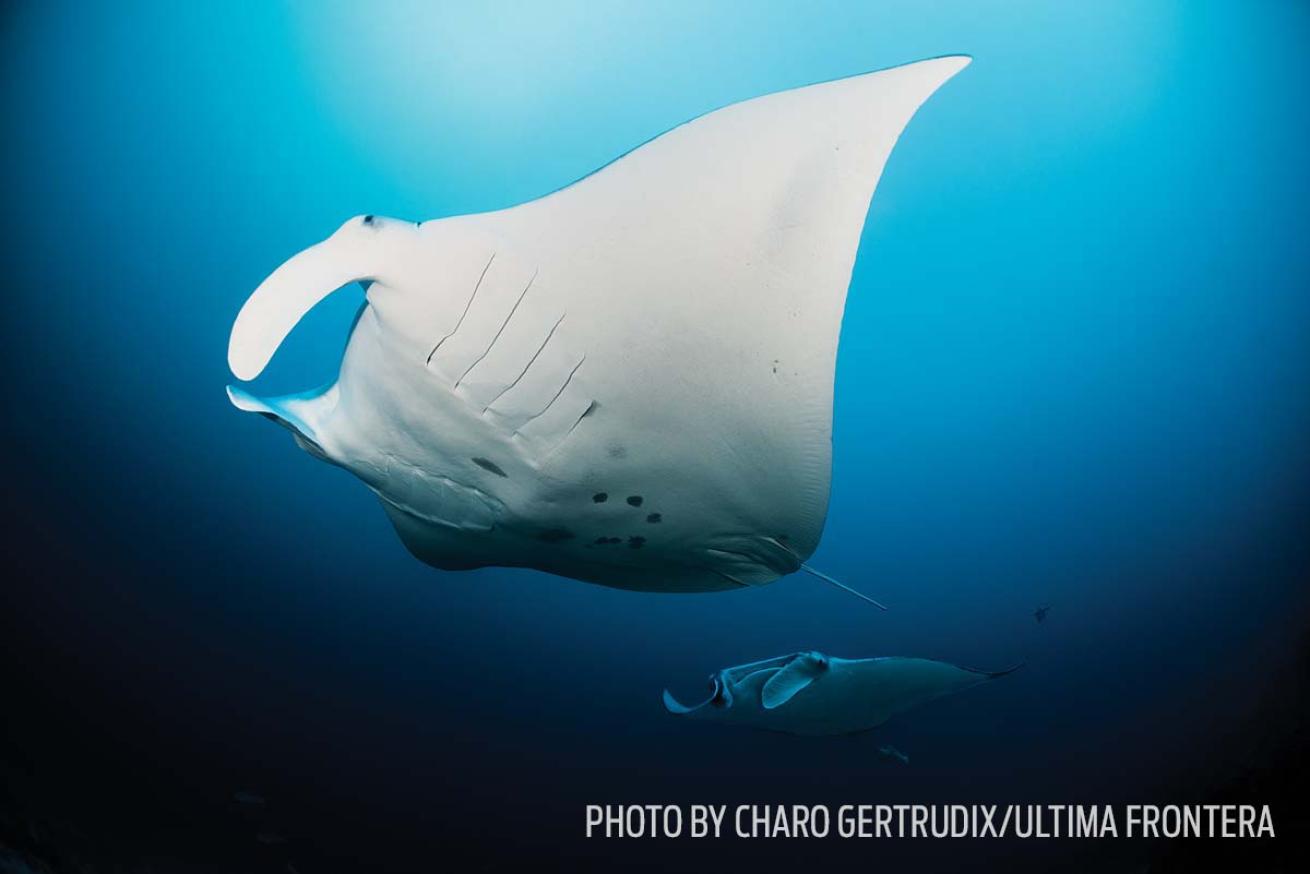
Charo Gertrudix/Ultima FronteraManta rays swim in the waters of the Maldives
6. Lankan Reef | Manta Point, Maldives | 50 feet
OK, we’re cheating a bit here including this one, since your depth gauge will register around 50 feet. But beyond resort house reefs, shallow dives are rare in the Maldives. And this one registers as one of the most thrilling you can have without going too deep. From May to November, you can see the spectacle of mantas descending — often by the dozens — at this spot off North Male Atoll. The animals theatrically swoop in to have their gills overhauled by hordes of cleaner wrasse camped out at two immense coral heads. “Divers gather a bit away from the [cleaning stations] and just observe the show these magnificent animals put on,” says Ibrahim Neezer, dive center manager at Four Seasons Resort Maldives at Kuda Huraa. The outgoing current is the best time to see the mantas, he says, and you’re also likely to spot hawksbill and green turtles, Napoleon wrasse, giant trevally, and blacktip sharks joining the fray. fourseasons.com/maldives
Deep-Dive Counterpart | HP Reef (aka Rainbow Reef)
100 FEET
A swim-through chimney, caves full of bright-blue soft corals, and an abundance of eagle rays, turtles, whitetip reef sharks and barracuda make this site off the south side of Girifushi Island a favorite for divers.
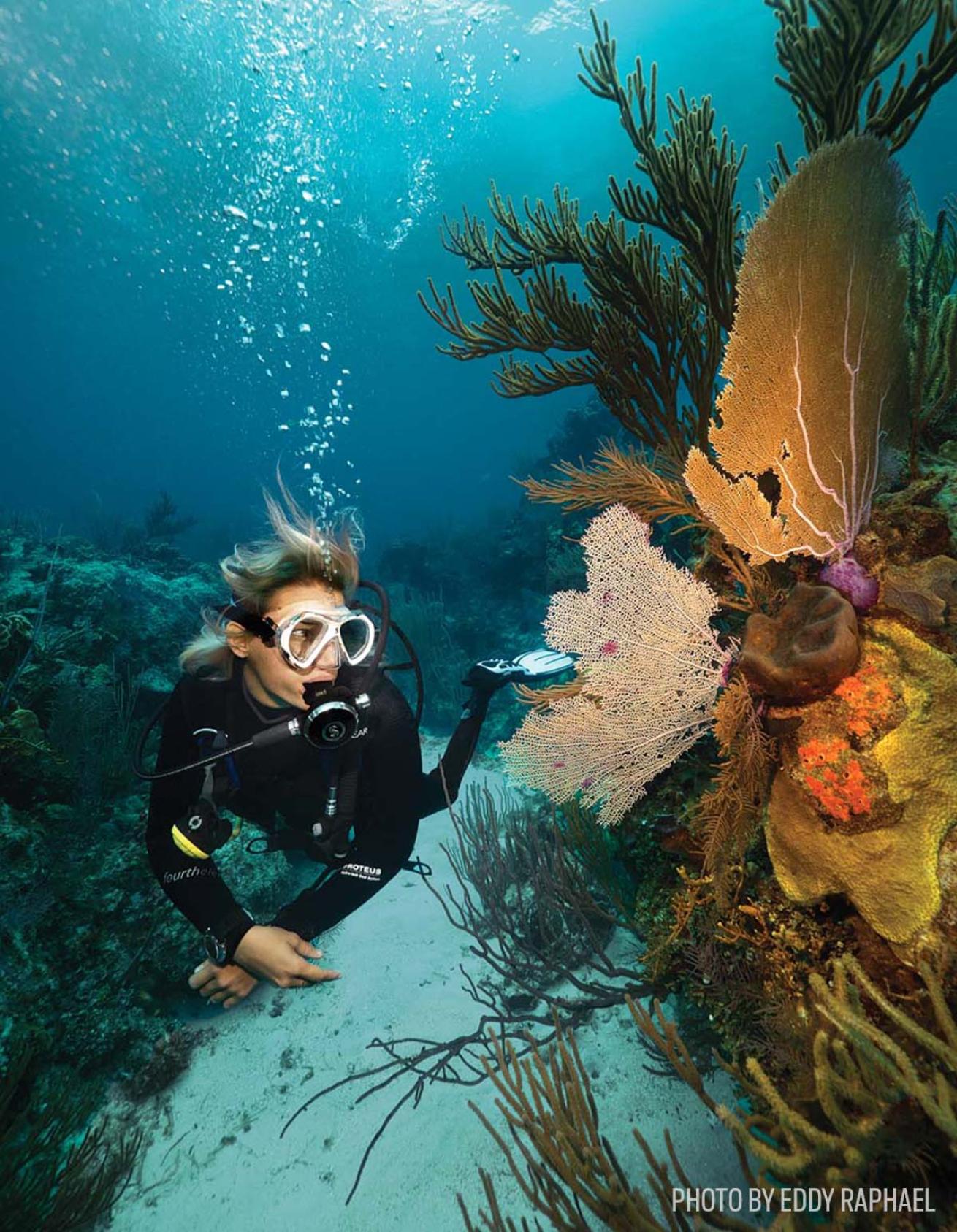
Eddy RaphaelDiving off New Providence, Bahamas
7. Southwest Reef | Nassau, Bahamas | 15 feet
This iconic New Providence reef lies in a mere 15 feet of water some 6 miles off the southwest coast of Nassau. Diving Southwest Reef is like finning through an aquarium. “It’s an oasis of coral situated on the edge of the Great Bahama Bank,” says Stuart Cove of Stuart Cove’s Dive Bahamas. “The nutrient-rich waters flow off the Great Bahama Bank over Southwest Reef and into the Tongue of the Ocean, creating fish-rich waters.” Massive boulders of star coral and stands of elkhorn coral are in immaculate shape, and the seascape waves with colorful sea whips and sea fans. The site is a gathering spot for trumpetfish and butterflyfish; peer into crevices to spot Caribbean spiny lobsters and other invertebrates. Rays and whitetip reef sharks have a habit of appearing out of the blue. stuartcove.com
Deep-Dive Counterpart | Port Nelson/Bacardi Bar
70 FEET
Schooling snapper, jacks and large African pompano are often sighted at this dive site, where a huge coral head meets the 130-footlong U.S. Coast Guard cutter Port Nelson before plunging down a sheer wall.
8. The Reeftop at Naia | Kona, Big Island, Hawaii | 15 feet
Because of the sloping volcanic nature of the island of Hawaii (aka the Big Island), the coastline is fringed with a seemingly endless amount of shallow reef dives. And the waters around the sheltered west coast near Kona are dotted with mooring buoys marking epic sites. One of the best shallow dive sites is Naia, located just outside Honokohau Harbor, where a sloping reef starts in only a few feet of water before dropping to 90 feet. The site is also referred to as Rip-Off Reef by locals, who joke that you don’t really need a boat to get here since you can enter from the shore or public pier (but trust us, boat entry is the way to go to avoid traipsing over lava rock). “There are lots of frogfish, devil scorpions and other hard-to-spot cryptics,” says Byron Kay, owner of Kona Honu Divers. “And dolphins, eagle rays and turtles also like to visit this spot.” Be sure to peer out into the blue occasionally too because barracuda and the site’s namesakes (naia is Hawaiian for “dolphin”) often cruise past. koahonudivers.com
Deep-Dive Counterpart | Predator Wreck
75 TO 96 FEET
Dive the wreck of a military landing craft purchased to serve as a shark-cage diving platform before it met its demise due to poor upkeep. There are two spooky plastic skeletons on board, and divers here often see the Atlantis submarine passing by.
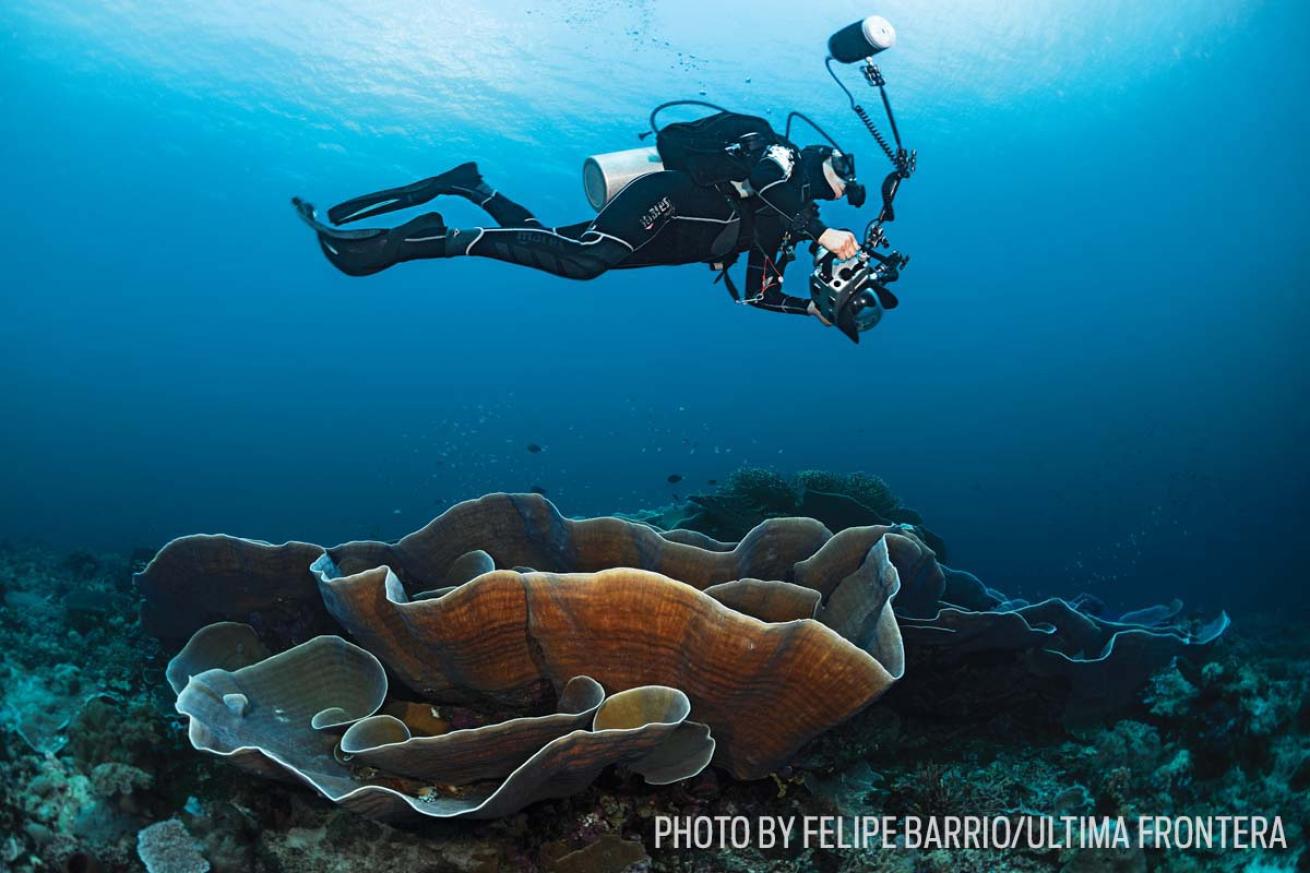
Felipe Barrio/Ultima FronterraAn underwater photographer fins past a disc coral in Wakatobi
9. Reeftop at Roma | Wakatobi, Sulawesi, Indonesia | 10 feet
Smack dab in the Coral Triangle, this diver’s haven on the southeast side of Sulawesi offers some of the world’s best diving at your doorstep. ( Wakatobi’s 3-mile-long house reef is enough to occupy you for weeks.) More than 40 dive sites are within a 10- to 60-minute boat ride of the resort’s pier. And locals quip that all the sandy channels here lead to Roma — an elongated coral ridge that rises from depths of more than 200 feet to within just a few feet of the surface. “Roma is one of the most subject-rich sites within the Wakatobi region,” says underwater photographer Walt Stearns. “Clear water and schools of barracuda and black snapper make for grand settings for wide-angle photography, and macro enthusiasts will find many small subjects hiding among the hard and soft corals.” Sunlight sparkles on clouds of pyramid butterflyfish, and iridescent anthias swarm among a Candy Land of hard corals. Look for banded sea snakes, eagle rays and hawksbill turtles cruising through the psychedelic scene too. wakatobi.com
Deep-Dive Counterpart | Blade
160 FEET
Named for the narrow, high-profile seamounts that rise knifelike in the water column, this drift dive thrills with massive sea fans, colorful crinoids and fishy scenes at every angle.
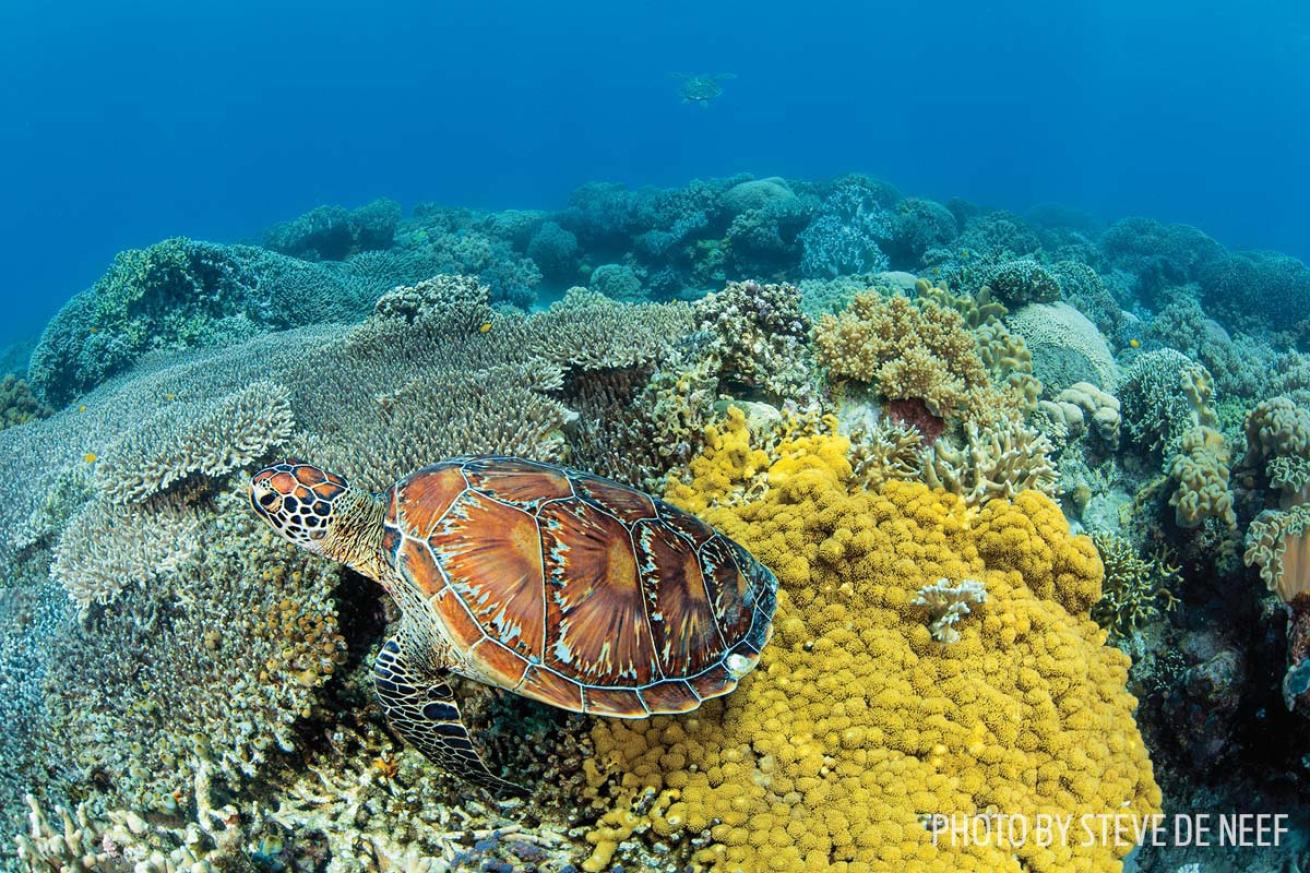
Steve de NeefA juvenile green sea turtle near Apo Island
10. Rock Point West | Apo Island, Southern Visayas, Philippines | 16 feet
“Walls of hard corals fighting over turf, coral formations that have grown over many years to out-of-this- world proportions, and endless fields of waving soft and leather corals on the shallow plateaus” — that’s how Philippine Siren cruise manager Ed Regeer describes the underwater vistas of Apo Island, which he calls a celebration of life and color. And while the volcanic island in the Visayas chain near Dumaguete might be diminutive, the waters around it put on a supersize show. The sloping plateau at the dive site called Rock Point West starts in just 16 feet of water, where luxurious carpets of colorful soft corals stretch endlessly. Hawksbill turtles come to munch on the corals, and look for tiny neon nudibranchs and what might look like misshapen sponges on sponges that are, in fact, perfectly camouflaged frogfish. sirenfleet.com
Deep-Dive Counterpart | Car Wreck
100 FEET
Macro lovers appreciate the sandy seascape around two sunken cars at the site in Dauin. Sea moths, ghost pipefish, squat lobster, juvenile frogfish and flamboyant cuttlefish abound.

